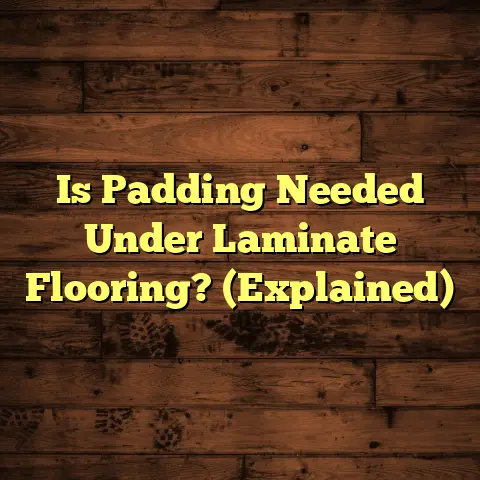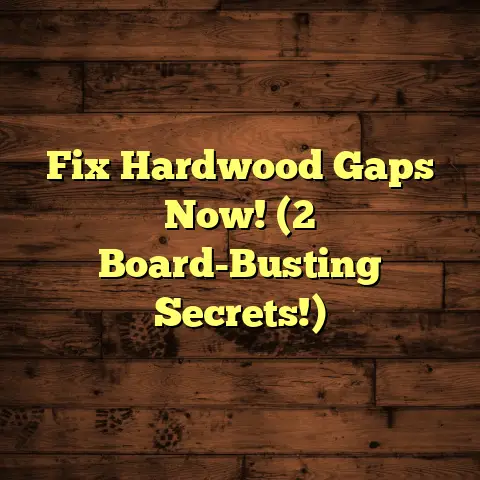Wood & Carpet Transitions (9 Install Tricks!)
Picture this: you walk into your home after a brutal day, the weight of the world crushing you.
As you step from the cozy carpet of your living room onto the smooth hardwood of your dining area, you feel a shift.
Not just in texture, but in the whole vibe of your home.
That transition from plush carpet to sleek wood?
It’s more than just flooring; it’s a transformation that shows off your style and boosts your comfort.
But let’s be real, getting that transition perfect can feel like a Herculean task.
Don’t sweat it!
I’m here to share nine killer tricks for installing seamless wood and carpet transitions.
These aren’t just about looks; they’re about making your home a place of harmony.
Let’s dive in!
Section 1: Understanding the Importance of Transitions
So, what exactly are wood and carpet transitions?
Basically, they’re the bridge between two different flooring types.
Think of them as the unsung heroes of your home’s interior design.
They’re the strips that cover the gap where your carpet meets your hardwood, tile, or laminate.
But why bother with them?
Well, for starters, they’re practical.
They prevent tripping hazards by creating a smooth surface.
They also protect the edges of your flooring from damage and wear.
Aesthetically, transitions are a game-changer.
They create a clean, finished look that elevates the entire space.
Ever walked into a room and felt like something was “off,” but couldn’t put your finger on it?
Chances are, it was a poorly executed transition.
Think about it: a well-placed transition strip can define different zones in an open-concept space.
It can guide the eye and create a sense of flow.
It’s all about making your home feel cohesive and intentional.
I’ve seen countless homes where the transition was an afterthought, a cheap plastic strip slapped down as a last resort.
And let me tell you, it shows.
It detracts from the overall design and makes the space feel unfinished.
On the flip side, I’ve also seen homes where the transitions were carefully considered and beautifully executed.
The result? A space that feels polished, sophisticated, and inviting.
Section 2: Selecting the Right Materials
Okay, so you’re convinced that transitions are important. Now, let’s talk materials.
There’s a whole world of transition strips out there, and choosing the right one can feel overwhelming.
The most common materials you’ll encounter are metal, wood, and vinyl.
-
Metal transitions are durable and sleek. They’re great for high-traffic areas and modern designs.
-
Wood transitions offer a warm, natural look. They’re perfect for blending with hardwood floors.
Vinyl transitions are budget-friendly and versatile.
They come in a wide range of colors and styles.
But material is only part of the equation.
You also need to consider the compatibility between your wood and carpet.
For example, if you have a thick, plush carpet, you’ll need a transition strip that can accommodate the height difference.
Otherwise, you’ll end up with a tripping hazard or a gap that lets in dirt and debris.
And don’t forget about color matching!
Ideally, you want your transition strip to complement both your wood and your carpet.
If you’re feeling bold, you can even use a contrasting color to create a statement.
I once worked on a project where the homeowner had dark hardwood floors and a light beige carpet.
We used a brushed brass transition strip to tie the two together.
The result was stunning!
It added a touch of elegance and sophistication to the space.
Here’s a pro tip: bring samples of your wood and carpet to the store when you’re shopping for transition strips.
That way, you can see how the colors and textures work together in person.
Section 3: Preparing the Subfloor for Installation
Alright, let’s get down to the nitty-gritty.
Before you even think about installing your transition strip, you need to prep your subfloor.
Why? Because a level subfloor is essential for a successful transition.
If your subfloor is uneven, your transition strip will rock and wobble.
This not only looks bad, but it can also create a tripping hazard.
So, how do you assess and prepare your subfloor?
First, grab a level and run it across the area where you’ll be installing the transition strip.
Look for any dips, bumps, or cracks.
If you find any imperfections, you’ll need to address them before moving on.
For small dips and cracks, you can use a self-leveling compound.
This stuff is like magic!
You simply pour it onto the subfloor, and it spreads out to create a smooth, even surface.
For larger bumps, you may need to grind them down with a concrete grinder.
This is a bit more involved, but it’s worth it to ensure a level surface.
I remember one job where the subfloor was so uneven that it looked like a roller coaster.
We spent hours grinding and leveling, but in the end, the transition strip looked perfect.
It was a lot of work, but it made all the difference.
Here’s a table that summarizes common subfloor issues and how to address them:
One more thing: make sure your subfloor is clean and dry before installing your transition strip.
Any dirt or debris can prevent the adhesive from bonding properly.
Section 4: Measuring for a Perfect Fit
Measuring is key!
Nothing screams “amateur” like a transition strip that’s too short or too long.
So, grab your measuring tape and let’s get to work.
First, measure the width of the doorway or opening where you’ll be installing the transition strip.
Write down the measurement and double-check it.
Remember, measure twice, cut once!
Next, consider any expansion gaps.
Wood floors expand and contract with changes in temperature and humidity.
You need to leave a small gap between the wood floor and the transition strip to allow for this movement.
A good rule of thumb is to leave a gap of about 1/4 inch.
Finally, account for the carpet pile height.
If your carpet is thick and plush, you’ll need a transition strip that’s tall enough to cover the edge of the carpet.
Otherwise, the carpet will look frayed and unfinished.
I’ve seen installers completely botch this, resulting in a gap between the transition strip and the carpet.
It’s not a pretty sight.
Here’s a tip: use a piece of scrap carpet to test the height of the transition strip before you cut it.
That way, you can make sure it’s the right size.
Section 5: The Installation Process
Alright, now for the fun part: installation!
The exact process will vary depending on the type of transition strip you’re using.
But here’s a general overview of the steps involved:
-
Gather your tools. You’ll need a measuring tape, saw (or miter saw), drill, screws, adhesive (if applicable), and safety glasses.
-
Cut the transition strip to size. Use your measurements from the previous step to cut the transition strip to the correct length.
Apply adhesive (if necessary). Some transition strips come with adhesive backing.
Others require you to apply adhesive separately.-
Position the transition strip. Carefully align the transition strip with the edge of the wood floor and carpet.
-
Secure the transition strip. Use screws or nails to secure the transition strip to the subfloor.
-
Clean up. Remove any excess adhesive or debris.
For gluing, use a high-quality construction adhesive that’s designed for flooring applications.
Apply the adhesive in a zigzag pattern to ensure good coverage.
For nailing, use finish nails that are long enough to penetrate the subfloor.
Be careful not to split the wood when you’re nailing.
I’ve found that using a nail set can help prevent splitting.
Here’s a table that summarizes the tools needed for different types of installation:
Section 6: Tricks for Achieving a Seamless Look
Okay, now for the real secrets.
These are the tricks that will take your transition from “meh” to “wow.”
First, let’s talk about cutting transition strips.
A miter saw is your best friend here.
It allows you to make precise, angled cuts.
If you don’t have a miter saw, you can use a hand saw and a miter box.
Just be sure to take your time and cut carefully.
Next, consider aligning wood grains and carpet patterns.
If your wood floor has a strong grain pattern, try to align the grain of the transition strip with the grain of the floor.
This will create a more cohesive look.
Similarly, if your carpet has a pattern, try to align the pattern of the carpet with the pattern of the transition strip.
This is a bit more challenging, but it’s worth the effort.
I once spent hours meticulously aligning the pattern of a Persian rug with the pattern of a wood transition strip.
The client was blown away by the attention to detail.
Finally, get creative with your transitions!
Don’t be afraid to think outside the box.
You can use different materials, colors, and shapes to create unique transitions that reflect your personal style.
For example, you could use a mosaic tile transition to add a pop of color to your space.
Or you could use a curved transition to create a softer, more organic look.
The possibilities are endless!
Section 7: Maintenance and Care Tips
So, you’ve installed your beautiful new transition strip.
Now, how do you keep it looking its best?
The key is regular maintenance and care.
First, sweep or vacuum your transition strip regularly to remove any dirt or debris.
This will prevent scratches and wear.
Next, clean your transition strip with a damp cloth and a mild detergent.
Avoid using harsh chemicals or abrasive cleaners, as these can damage the finish.
For wood transitions, you may want to apply a coat of wood polish or wax every few months to protect the wood and enhance its shine.
For metal transitions, you can use a metal polish to remove any tarnish or oxidation.
And for vinyl transitions, you can simply wipe them down with a damp cloth.
Here’s a table that summarizes cleaning methods for different materials:
If you notice any wear and tear, such as scratches or chips, you can often repair them with a touch-up kit.
These kits typically include a filler and a paint that matches the color of your transition strip.
Section 8: Troubleshooting Common Issues
Even with the best planning and execution, things can sometimes go wrong.
Here are some common issues you might encounter and how to solve them:
-
Gaps: If you have gaps between your transition strip and the wood floor or carpet, you can fill them with caulk or wood filler.
-
Misalignments: If your transition strip is misaligned, you can try loosening the screws or nails and repositioning it.
Movement: If your wood floor is expanding and contracting excessively, it can cause the transition strip to move or buckle.
In this case, you may need to adjust the expansion gap.Loose transition strip: If your transition strip is loose, you can try tightening the screws or nails.
If that doesn’t work, you may need to reapply adhesive.
I once had a client who complained that their transition strip was constantly coming loose.
After some investigation, I discovered that the subfloor was damp, which was preventing the adhesive from bonding properly.
We installed a moisture barrier, and the problem was solved.
Section 9: Inspiring Examples of Wood & Carpet Transitions
Okay, let’s get inspired!
Here are some examples of successful wood and carpet transitions in real homes:
-
Modern Minimalist: A sleek metal transition strip between a light hardwood floor and a gray wool carpet.
-
Rustic Chic: A reclaimed wood transition strip between a dark hardwood floor and a jute rug.
-
Bohemian Eclectic: A mosaic tile transition between a patterned wood floor and a colorful shag carpet.
I’ve seen countless homes where the transition was the finishing touch that tied the whole space together.
It’s amazing how much of a difference a well-executed transition can make.
Conclusion
So, there you have it: nine essential tricks for installing seamless wood and carpet transitions.
I hope this article has inspired you to tackle your own flooring projects.
Remember, your home is a reflection of you.
It’s a place where you can express your style, create memories, and feel comfortable and safe.
And the right wood and carpet transitions can enhance that feeling in a big way.
So, go out there and create beautiful and functional spaces that tell your personal story!
Call to Action
Now, I want to hear from you!
What are your experiences with wood and carpet transitions?
Do you have any tips or questions to share?
Leave a comment below and let’s start a conversation!





